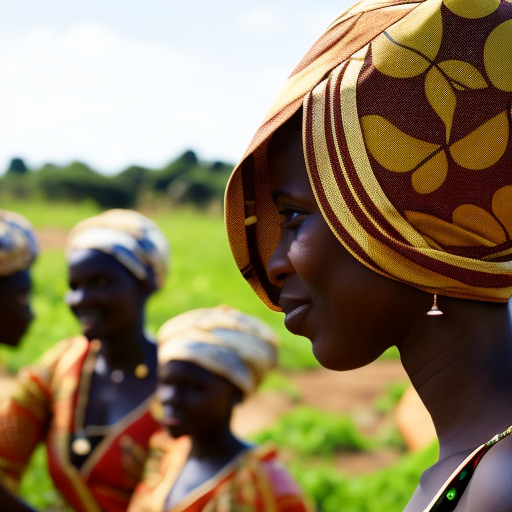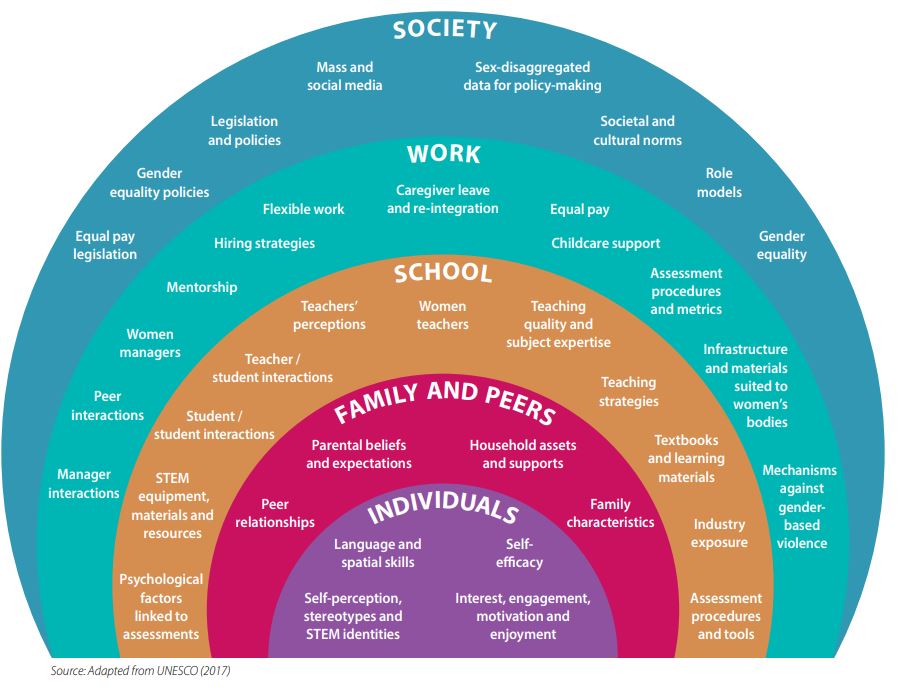
Get gender equality right in Africa, and prosperity will follow
Realistic reductions in gender inequality could produce a US$259 billion larger economy in 2043 than current path forecasts.
Published on 06 May 2024 in ISS Today
By Kouassi Yeboua, Senior Researcher, African Futures and Innovation, ISS Pretoria

Rising global fragility fuelled by conflicts, COVID-19, the Russia-Ukraine war and climate change have worsened gender disparities worldwide.
In Africa, women often face greater vulnerability to climate change due to their social roles, economic circumstances and limited access to resources. They are more likely to rely on climate-sensitive sectors like agriculture, making their livelihoods susceptible to changing weather patterns, droughts, floods and other climate-related risks. And women are disproportionately represented in the informal economy, which was seriously impacted by COVID-19.
Gender inequalities in Africa are rooted in social and cultural norms and traditions. Despite progress in policy and legislation, the continent is far from achieving gender equality. Sub-Saharan Africa is the worst-performing region in the United Nations Development Programme’s Gender Inequality Index (see chart) – a composite measure reflecting the disparity between women’s and men’s achievements in reproductive health, empowerment and the labour market.
Gender Inequality Index

At this rate, estimates are that achieving full gender equality in Africa will take over a century. Gender disparities affect education, healthcare, employment, political representation and access to resources.
African women are more likely to die from communicable diseases such as HIV, tuberculosis, malaria and nutritional deficiencies than men. Although maternal healthcare on the continent has improved in the past two decades, sub-Saharan Africa accounts for around 70% of global maternal deaths, due to gender bias in healthcare access.
Women and girls in Africa also bear the greatest burden of unpaid care and domestic work. They face a higher risk of violence especially at home, and are under-represented in the labour market and politics, governance and decision making. In 2019, women made up 56% of Africa’s average labour force, compared to men’s 73% – an improvement from a 23 percentage-point gap in 1990.
Regionally, the greatest gap is in North Africa, where the female labour force participation rate was about 22% in 2019 compared to 70% for men. Although North Africa has lower gender inequality in education, this hasn’t meant progress for women in the labour market. In 2021, the World Bank reported that women in the region face unfair laws that economically disempower them. Countries such as Egypt, Morocco and Tunisia prohibit women from working in certain industries.
In African parliamentary bodies, women hold on average 24% of seats, while their presence in top executive roles is just 7%. Despite local governments being perceived as entry points for women in politics, women hold only 21% of African council positions. Of the few examples of progress, Rwanda, Namibia, South Africa and Senegal rank among the top 10 nations globally for female parliamentary representation.
Even in education, where Africa has made significant progress in reducing gender inequality, girls in sub-Saharan Africa are still the most disadvantaged compared to other global regions. Widespread child marriage, teenage pregnancy, poverty and the social norm of valuing boys over girls are among the factors that constrain women’s access to education.
Climate change compounds these inequities. African women – constrained by societal roles, economic status and restricted resource accessibility – are disproportionately vulnerable to climate change impacts.
Closing these gender inequalities would have major benefits. New research by the Institute for Security Studies’ African Futures and Innovation programme shows what Africa’s development could gain from more gender inclusion.
Using progress made by other countries or regions at similar levels of development as a benchmark, the study models the impact of an ambitious but realistic reduction in gender inequalities (Gender scenario) on Africa’s development prospects to 2043. The report also includes an illustrative Gender Equality scenario that models the effect of full gender equality by 2043, with the full knowledge that this isn’t practically achievable.
The services sector shows the greatest benefit from reduced gender inequalities
In the Gender scenario, the 2043 African economy is about US$259 billion larger than in the business-as-usual forecast. The services sector greatly benefits from reduced gender inequality, gaining US$174 billion in added value compared to the current growth trajectory by 2043.
Reduced gender barriers in the scenario accelerate women’s movement from agriculture to other sectors, particularly the service sector. While most women are still employed in agriculture, those in Africa’s service sector have been increasing in number partly due to shifting social norms. In the Gender scenario, Africa’s GDP per capita is US$355 more than the business-as-usual forecast by 2043, and there are 53 million fewer extremely poor people.
Even more impressive is the illustrative full Gender Equality scenario. It shows an African economy US$1 trillion larger than the Current Path forecast. GDP per capita is 12% higher, and Africa has 80 million fewer people in extreme poverty compared to the Current Path forecast in 2043.
These findings imply that aggressively implementing policies to reduce gender inequality and create a level playing field for all could significantly enhance African growth and development.
Policies must confront deep-rooted cultural and traditional values as the primary cause of gender inequality. Governments should prioritise implementing international and regional conventions to decrease gender disparities, especially in rural areas where discriminatory practices persist unchecked. Involving religious and traditional leaders in awareness campaigns and education is crucial.
Investing in free education up to secondary level could significantly promote gender equality in education. Governments should combat child marriage and teenage pregnancies, ensuring a minimum marriage age of 18 and improving access to contraceptives and sex education. Encouraging girls and women to pursue science, technology, engineering and mathematics programmes through scholarships and role models can narrow the gender gap in lucrative sectors.
Reproductive health services, legal reforms to address land ownership disparities, and gender-sensitive agricultural programmes are also vital. Removing legal barriers to women’s employment, investing in infrastructure that reduces time spent on household production,
SDGs, Targets, and Indicators
1. Which SDGs are addressed or connected to the issues highlighted in the article?
- SDG 5: Gender Equality
- SDG 3: Good Health and Well-being
- SDG 4: Quality Education
- SDG 8: Decent Work and Economic Growth
- SDG 10: Reduced Inequalities
- SDG 13: Climate Action
2. What specific targets under those SDGs can be identified based on the article’s content?
- SDG 5.1: End all forms of discrimination against all women and girls everywhere
- SDG 5.2: Eliminate all forms of violence against all women and girls in the public and private spheres, including trafficking and sexual and other types of exploitation
- SDG 5.4: Recognize and value unpaid care and domestic work through the provision of public services, infrastructure, and social protection policies and the promotion of shared responsibility within the household and the family
- SDG 3.1: By 2030, reduce the global maternal mortality ratio to less than 70 per 100,000 live births
- SDG 4.1: By 2030, ensure that all girls and boys complete free, equitable, and quality primary and secondary education leading to relevant and effective learning outcomes
- SDG 8.5: By 2030, achieve full and productive employment and decent work for all women and men, including for young people and persons with disabilities, and equal pay for work of equal value
- SDG 10.2: By 2030, empower and promote the social, economic, and political inclusion of all, irrespective of age, sex, disability, race, ethnicity, origin, religion, or economic or other status
- SDG 13.1: Strengthen resilience and adaptive capacity to climate-related hazards and natural disasters in all countries
3. Are there any indicators mentioned or implied in the article that can be used to measure progress towards the identified targets?
- Gender inequality index (mentioned in the article)
- Maternal mortality rate (mentioned in the article)
- Female labor force participation rate (mentioned in the article)
- Percentage of women in parliamentary bodies and top executive roles (mentioned in the article)
- Gender gap in education (mentioned in the article)
- GDP per capita (mentioned in the article)
- Number of people in extreme poverty (mentioned in the article)
SDGs, Targets, and Indicators Table
| SDGs | Targets | Indicators |
|---|---|---|
| SDG 5: Gender Equality | 5.1: End all forms of discrimination against all women and girls everywhere 5.2: Eliminate all forms of violence against all women and girls in the public and private spheres, including trafficking and sexual and other types of exploitation 5.4: Recognize and value unpaid care and domestic work through the provision of public services, infrastructure, and social protection policies and the promotion of shared responsibility within the household and the family |
Gender inequality index |
| SDG 3: Good Health and Well-being | 3.1: By 2030, reduce the global maternal mortality ratio to less than 70 per 100,000 live births | Maternal mortality rate |
| SDG 4: Quality Education | 4.1: By 2030, ensure that all girls and boys complete free, equitable, and quality primary and secondary education leading to relevant and effective learning outcomes | Gender gap in education |
| SDG 8: Decent Work and Economic Growth | 8.5: By 2030, achieve full and productive employment and decent work for all women and men, including for young people and persons with disabilities, and equal pay for work of equal value | Female labor force participation rate |
| SDG 10: Reduced Inequalities | 10.2: By 2030, empower and promote the social, economic, and political inclusion of all, irrespective of age, sex, disability, race, ethnicity, origin, religion, or economic or other status | Gender inequality index |
| SDG 13: Climate Action | 13.1: Strengthen resilience and adaptive capacity to climate-related hazards and natural disasters in all countries | N/A |
Copyright: Dive into this article, curated with care by SDG Investors Inc. Our advanced AI technology searches through vast amounts of data to spotlight how we are all moving forward with the Sustainable Development Goals. While we own the rights to this content, we invite you to share it to help spread knowledge and spark action on the SDGs.
Fuente: issafrica.org

Join us, as fellow seekers of change, on a transformative journey at https://sdgtalks.ai/welcome, where you can become a member and actively contribute to shaping a brighter future.






